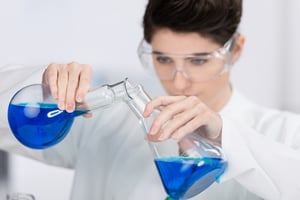In a lab, basic safety equipment can make the difference between coming out of an accident unscathed and needing medical treatment.
Particularly lab safety goggles play a critical role in protecting a worker’s eyes, especially when an individual works with chemicals, machinery, laser light and biological hazards.
Knowing when and why workers should wear them, as well as what types of goggles are necessary, is an important step in ensuring optimal lab safety.
When Workers Need Lab Safety Goggles
Safety goggles are a common piece of lab safety equipment found in different types of laboratories, including biology, chemistry, physics, product testing, pharmaceutical and more. There are several common types of eye hazards in a lab, including:
biology, chemistry, physics, product testing, pharmaceutical and more. There are several common types of eye hazards in a lab, including:
- Chemicals
- Gases
- Fumes
- Vapors
- High-energy light
- Machinery
- Particles
- Laser light
- Ultraviolet light
- Bloodborne pathogens
Other circumstances may call for the use of safety goggles as well, such as when:
- Glassware is being used
- Heating sources are being used
- Working with materials under stress, pressure or force
- An activity may generate projectiles such as when using springs or wire
- Preserving or working with specimens
Why Workers Need Safety Goggles
Each of the above hazards and environments dictates the need for safety goggles. While wearing safety goggles does not prevent accidents from happening, they can prevent serious injuries resulting from them.
In fact, eye injuries are very common in the workplace. According to the National Institute for Occupational Safety and Health (NIOSH), about 2,000 workers in the United States sustain eye injuries daily. Of these injuries, the majority result from small particles or objects scraping the eye. Examples of small particles include dust, wood chips, metal slivers and cement chips.
Other injuries workers sustain include:
- Large objects striking the eye, causing blunt force trauma
- Penetration from nails, staples or slivers of wood or metal
- Chemical or thermal burns from cleaning products, industrial chemicals or heating tools
If a lab deals with bloodborne pathogens, workers can acquire eye diseases as well in the event a spill or splash occurs. Eye diseases can be transmitted through the eye’s mucous membranes. While reddening or eye soreness may occur, workers may face more serious health issues like HIV or hepatitis B.
However, the American Optometric Association estimates that the right eye protection can prevent or lessen the severity of 90% of these eye injuries.
Another important note to keep in mind is for workers who wear contact lenses. Historically, many employers have prohibited their employees from wearing contact lenses, especially if they work in a lab where chemicals are present. However, the American Chemical Society (ACS) Committee on Chemical Safety and NIOSH say workers can wear contact lenses as long as approved eye protection is worn.
Types Of Eye Protection
There are two types of eye safety goggles: vented and non-vented. 
Non-vented goggles protect a worker’s eyes from vapors, mists and fumes, as well as any other hazards that would require eyes to be completely shielded such as chemicals or bloodborne pathogens.
Vented goggles provide a moderate amount of protection from liquids as long as they do not emit vapors or mist. Some laboratory goggles allow air to pass through but include a physical barrier to liquids. Other vented goggles, like those found at a hardware store that have holes in the plastic, would not be suitable for some lab environments.
In addition to goggles, there are other types of safety eyewear that could offer protection in labs.
Safety glasses often have shatter-resistant lenses and are designed to stop large objects from injuring eyes. They also may be designed to provide laser light filtration or to prevent laser reflections from entering the eye. While safety glasses do not offer as much protection from liquids and vapors as safety goggles, they can offer protection in the appropriate environments.
Another option are face shields. While face shields are not designed to be the only eye protection a lab worker should wear, they can help provide additional protection when worn over safety goggles. Face shields also help protect the entire face, rather than only eyes.
Lab Safety Goggle Standards
When purchasing safety goggles for your employees, it’s critical that they meet certain safety standards. The American National Standards Institute (ANSI) regulates these safety standards. The organization implements a defined set of tests that goggles must pass in order to be labeled as meeting the appropriate ANSI standards.
The literature that accompanies the safety goggles should clearly show that the equipment has met standard ANSI-Z87. On the goggles themselves, they should have a label that says “Z87.”
Additional markings will identify other protections including splash (D3), dust (D4) or fine dust (D5). For example, chemical splash goggles would have a label that looks like, “Z87+D3.” If you want protection from both splash and dust, you would look for a label that reads, “Z87+D3D4.”
Lab Safety Goggle Tips
To ensure employees are getting the most protection out of their lab safety goggles, here are five important tips.
- Safety goggles should fit snugly to the face surrounding the eyes.
- For prescription glasses wearers, choosing a safety goggle specifically made to be worn over top glasses.
- Replace goggles that have been damaged, including goggles that have been scratched since this can reduce visibility.
- Combine goggles with machine guards, such as a fume hood sash, to optimize safety.
- Have safety protocols in place that dictate when a worker should wear safety goggles. Make sure these protocols are regularly reviewed and are a part of standard employee training.
Even with safety protocols in place, accidents still happen. That’s why it’s important to have lab safety equipment such as eye washing stations and showers on hand. You can read more about this equipment that helps protect workers in the event of an emergency in our article, Lab Safety Equipment Every Laboratory Should Have.


